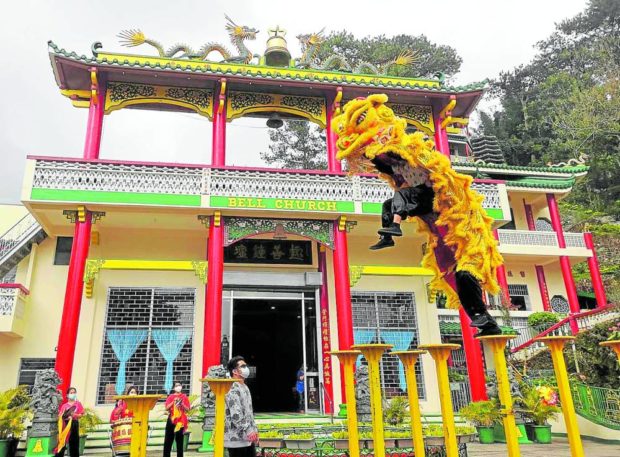
TRAINING: Performers for Bell Church’s dragon and lion dances are mostly students from the Chinese-Filipino community in Baguio City and Benguet or from local neighborhoods. Trained like athletes, the latest generation of dancers have resumed their rehearsals during the pandemic whenever quarantine and health protocols allowed them to gather for brief sessions during weekends.
LA TRINIDAD, Benguet, Philippines — Young people, some of them without face masks, spent their morning on Jan. 24 at the pagoda gardens of Bell Church, which has drawn tourists in the past 62 years at the border of this Benguet capital town and Baguio City.
Inside the temple, a woman burned incense at an altar devoted to five Chinese icons who symbolize the philosophies of the world’s major religions — Buddhism (Tao-Jih-Fu-Tsun), Taoism (Chang Tze-Fang), Confucianism (Liau Chen Shan Shr), Christianity (Lian Tai Sheng Mu), and Islam (Leu Chun Yang).
Like many Baguio spots, Bell Church experienced a sudden drop in visitors within the last three weeks because of the threat posed by the highly transmissible Omicron variant of COVID-19 following an influx of tourists during the holiday season.
The temple has remained open but Sunday afternoon services have been suspended because of pandemic restrictions.
However, in the run-up to this year’s Spring Festival on Feb. 1, the new year in the Chinese calendar, residents from both sides of the border are expected to flock to the temple.
“They’ll start coming soon [to seek guidance or divine intervention for their future],” Francis Brito, Bell Church’s administrative officer and main resource person, told the Inquirer.
Generations of Filipino families, including Chinese Filipinos who are fundamentally Christian, may have adopted modern practices but Bell Church continues to be the anchor to their Chinese heritage and culture, he said.
Before the pandemic, Baguio and La Trinidad residents visited this institution during the Spring Festival to pray for good fortune. Along downtown Session Road in Baguio, families would come out to watch the parade, featuring lion dance performers, as they joined the Chinese Filipino welcome the new year.
FAVORITE BACKDROPS: The pagoda-style arch and building facade of the 62-year-old Bell Church have drawn both devotees and tourists for decades, with these structures becoming backdrops in family albums of Baguio visitors through the years.
Subdued
Celebrations this year will be as subdued as the first two pandemic years, but a recording of a lion dance performance will be streamed online “to show people that we are still here,” Brito said.
Bell Church offered people hope when livelihood was scarce and businesses were shuttered at the start of the pandemic in 2020, and “hope is still what it offers in 2022, the Year of the Water Tiger,” said businessman Peter Ng, who owns the Hotel Supreme located about a block away from the temple.
For Chinese-Filipino families, Bell Church reminds them to be “good team players during difficult times,” Ng said, adding that it meant “taking care of each other and loving and supporting each other so we can continue to play together [in the fields of business, the academe or other enterprises].”
‘Unique place’
Bell Church started as a nondescript Buddhist temple, which was put up at the home of post-World War II Cantonese migrant Ng Pee in Betag village here.
The actual Bell Church was soon built “because the family found itself overwhelmed with guests,” Brito said.
There were no available records that would detail its beginnings, except for an old Cantonese sign that referred to August 1960 as the year the Bell Church was established.
In his 2014 book, “After Migration and Religious Affiliation: Religions, Chinese Identities and Transnational Networks,” Malaysian anthropologist Chee-beng Tan described Bell Church as a “unique place of worship” for devotees of Jigong, a monk and folk hero in the 1100s who was revered as a meat-eating, beer-drinking champion for justice.
Devotees whose wishes had been granted through their prayers at Bell Church soon built nine other similar churches in Manila, Dagupan City in Pangasinan province, and parts of Mindanao, Tan wrote.
He said the Bell Church philosophy was an example of religious syncretism, or the assimilation of various spiritual traditions.
Brito described it as a movement called Bellinism (sometimes called the bell religion), which is technically the “harmonization of Buddhism and Taoism,” to which church members have subscribed since the late 1950s and 1960s.
Jigong and Chinese general Quan Qong are some of the deities who inspire the most number of devotees at Bell Church, he said. Quan Qong was legendary in China for his humility, compassion and wisdom during the Chiwu era (196 to 247).
The larger Filipino community has been more familiar with Bell Church’s lion dancers. The first dancers were the children of the original members, but the group soon evolved into an athletic club composed of grade school and high school students, both girls and boys, as well as young professionals and college students who saw the performances as their duty, said Brito, who is one of its many coaches.
Training also slowed down because of health regulations. But a core group of about 30 dancers has since resumed lion dance practices, said Brito, who used to be part of the team.